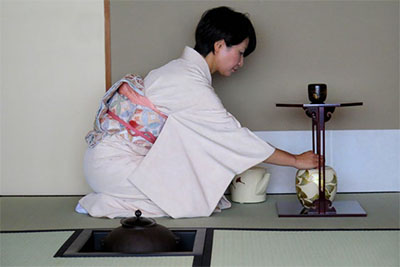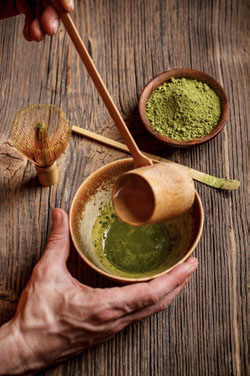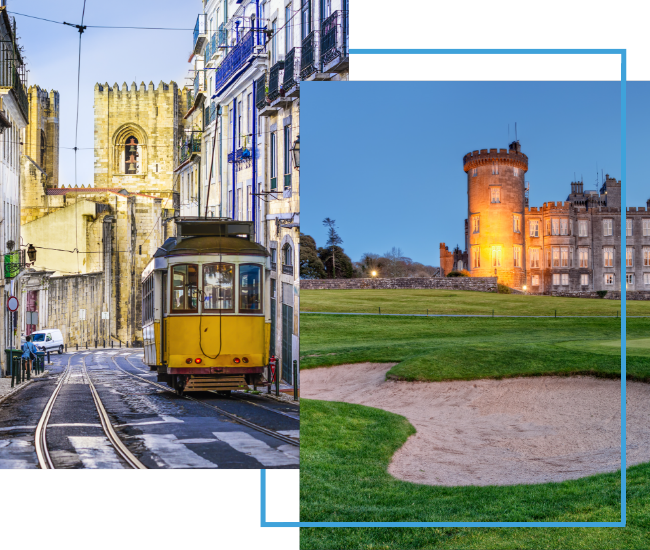TAKING PART IN A JAPANESE TEA ceremony might seem like a charming but archaic experience, with little relevance to our busy lives. But like meditation or a walk in the woods, the tea ceremony can clear the mind of the banalities of everyday life and serve as a pathway to spiritual peace. In fact, the Japanese word for the tea ceremony is chado (also cha-no-yu), the Way of Tea, which only hints at the protocols this highly choreographed ritual demands.
I learned this years ago when a fellow guest staying at the same Japanese inn asked whether she could practice her art by serving me tea. The Japanese woman apologized for her ineptitude, explaining she was only an apprentice and had much to learn. When I asked how long she’d been studying, her answer of “only seven years” stunned me. But then I watched how much attention she paid to every minute detail, from how she prepared the matcha green tea to how she served it. I realized that comparing the Japanese tea ceremony to a tea bag in hot water was like equating my haphazard bouquets to, well, ikebana, the Japanese art of flower arranging.
Tea found its way to Japan via China around the ninth century, when it was used mostly for medicinal and religious purposes, including as a stimulant for Buddhist monks during long sessions of meditation. It spread to the upper class, including feudal lords who embraced the ceremony’s rituals and constructed rustic huts just for the occasion, usually in the midst of a tranquil, landscaped garden. The tea ceremony, therefore, developed utilizing the principles of Zen and the spiritual discipline of the samurai, with an emphasis on simplicity, harmony, hospitality and decorum.

Tea ceremony masters © BETH REIBER
Today, chado follows a strictly prescribed procedure, with every step carrying a profound meaning and following principles laid out mostly by Japan’s most famous tea master, Sen no Rikyū, in the 16th century. Rules dictate the exact positioning of tea utensils; the lighting of the charcoal to warm the water; and each and every movement during the preparation, serving and drinking of tea. Similar to many other disciplines in Japan, the specifics of the ceremony change with the seasons, including the choice of tea bowl, the sweets served to counteract the bitterness of matcha and the simple flower arrangement that decorates the tearoom’s alcove. The tea ceremony even has its own vocabulary, and guests are assigned rankings, sitting order and duties. Because the rules are so intricate, tea schools are popular, not only for their disciplinary training in mental composure but also for their emphasis on etiquette and manners.
Traditionally, a teahouse is modestly small, big enough only for up to five guests. After removing shoes, guests gain access through a door that is so low, they must bow or crawl to enter, considered an expression of humility, with seating on the tatami floor. The host begins the ceremony by cleaning the tea utensils and then combines powdered green tea and hot water in a tea bowl, whisking them into a frothy blend. When the first guest receives tea, he or she says, “Osakini shitsureishimasu” to the next guest waiting in line to receive tea, essentially apologizing for drinking first. The second guest then repeats the phrase to the third guest, and so on down the line. It’s appropriate to admire the tea bowl and compliment the host on the excellent flavor of the tea.
In reality, however, the tea ceremony varies greatly depending on where it’s performed and how much time you can devote. In Tokyo, the easiest way to experience a curtailed version is in a hotel, with the Imperial, Keio Plaza and New Otani hotels offering ceremonies lasting 20 to 30 minutes in traditionally decorated tearooms to hotel guests and non-guests alike.

Matcha tea used for the tea ceremony © GRAFVISION | DREAMSTIME.COM
Nothing, however, beats a tea ceremony with a view of a gorgeous, landscaped garden.
Hotel Chinzanso Tokyo takes advantage of its beautiful garden with ceremonies available to hotel guests in one of its traditional teahouses. Japan’s famous landscaped gardens often have teahouses, set mostly overlooking ponds, where you can sit on tatami, drink the frothy matcha, nibble on a sweet and contemplate the view. There are also organizations around the country offering tea ceremonies and other traditional experiences, such as Tea Ceremony Waraku in Osaka and Joukeian in Kyoto.
Regardless of where you experience the tea ceremony, it’s easy to see why it has long enjoyed cult status as a way to cleanse the mind. Even samurai in the midst of war campaigns used the tea ceremony as spiritual therapy. My most memorable tea ceremony experience came in Kanazawa’s small Gyokusen-en garden, when my hostess, Ms. Nishida-san, an elderly woman dressed elegantly in kimono, said, “The tea ceremony is not a show but rather the chance to share our one moment together.” I knew I would probably never see her again, and for that instant, the peaceful garden and her poignant message made life stand still.
Info to Go
Narita International Airport outside Tokyo and Kansai International Airport serving Osaka and Kyoto are both readily served by limousine bus traveling directly to major hotels and by train. Tokyo’s Haneda Airport, closer and more convenient than Narita, is increasingly serving international flights, including those from the United States.
Read This Next
Boston’s Booming Economy
July 2017
Jul 1, 2017All Reads on This Topic
Read Them All

Introducing
FX Excursions
FX Excursions offers the chance for once-in-a-lifetime experiences in destinations around the world.
#globility
Insta FeedSlideshow
Apr 19, 20247 Reasons to Put Curaçao on Your Travel List
It’s time to start dreaming of your next trip. Here’s some destination inspiration for you. Take a visual journey through Curaçao with us.
Sponsored Content
Share Your Travel Preferences with Global Traveler in a Short Survey & Win
Learning more about our readers’ travel habits and preferences ensures Global Traveler delivers the content you desire. As the travel industry has adapted and changed over the last few years, it’s more important than ever to connect. To best meet your short- and long-term travel content needs, please help us!
Daily
Apr 19, 2024The Iconic Bayeux Tapestry in France to Get New Home
Under the direction of the Town of Bayeux, France, in close collaboration with the French government, the Normandy Region and the Department of Calvados, the project to move the famous 11th-century Bayeux Tapestry to a new space has been approved.
Daily
Apr 19, 2024Turtle Bay Resort Partners with Salesforce
Turtle Bay Resort and Salesforce recently announced a partnership. Salesforce will help the O’ahu-based resort augment service agents with AI and personalize the entire guest experience. Salesforce’s Einstein 1 Platform will help the resort with its efforts to reinvent itself, heighten awareness of its offerings and establish new customer relationships.
Sponsored Content
Tips to Plan a Destination Event Worth the Trip
Corporate events can often feel … too corporate. Where to go to get the team out of the office environment to bond and think outside the box? Starting with an unconventional, unique space to make them feel like the all-stars they are will get the juices flowing and make your LinkedIn profile glow.
Daily
Apr 18, 2024Fort George Hotel & Spa Transforms Belize City from Gateway to Destination
Belize City is better known as a business center and a stop en route to Belize’s lush rural destinations, but Fort George Hotel & Spa promises to change things up and reframe the nation’s capital as a destination in its own right. Located in the city’s Fort George neighborhood, the hotel debuted as the first luxury hotel in Belize City, boasting sophisticated design, elevated culinary offerings, expansive guestrooms and an inspiring wellness program. The hotel also features a branded fitness center, plunge pool and K’IN Spa.
Amansara Review
eFlyer Reviews
Apr 17, 2024Regent Santa Monica Beach to Debut This Summer
Daily
Apr 17, 2024eFlyer News
Apr 17, 2024Icelandair, Expedia Launch New Rewards Program
Icelandair and Expedia officially partnered to launch a new rewards program. Travelers can now earn more rewards from bookings.
Sponsored Content
Unearth Seoul’s Hidden Gems
Filled with hidden treasures waiting to be discovered, Seoul invites travelers to unearth its many gems, and Seoul Tourism Organization is here to help travelers do just that. Through thoughtfully created initiatives like the Theme Tourism County Competition, Seoul Tourism Organization works closely with local districts to identify and showcase what makes each district unique and charming in all seasons.
eFlyer News
Apr 17, 2024Swiss International Air Lines Begins New Service from Washington, D.C., to Zürich
Swiss International Air Lines recently launched daily flights from Washington, D.C. (IAD), to Zürich (ZRH). The daily flight is one of three new international routes SWISS launches this summer season, with Toronto (YYZ) and Seoul (ICN) slated in the coming months.
ShareThis